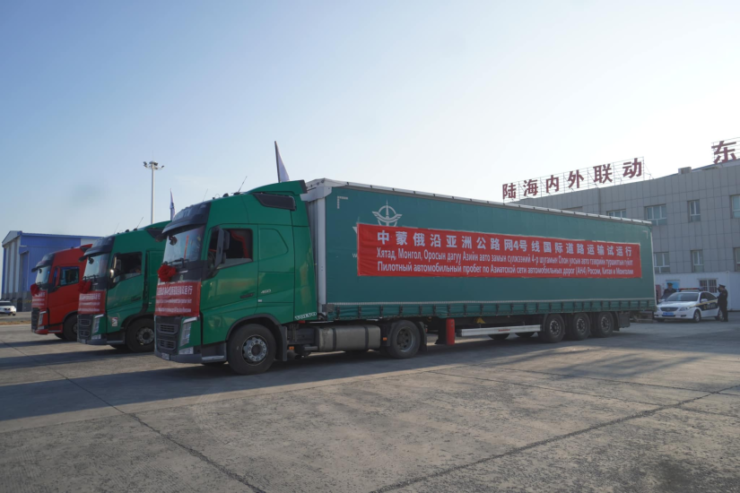
The test run of Russian, Mongolian and Chinese transport companies took place on 22nd of September, 2023 along the AH4 international highway, which connects Novosibirsk with the Pakistani city of Karachi through the territory of Mongolia and China. The length of the highway is more than 6,000 kilometers. In November 2022, the Mongolian section of the highway was brought into use. This run was held in order to identify the degree of serviceability of this way, on the roads of which transit traffic on “The Asia-Europe” route will be carried out.
Cargo transportation along this route between Russia, China and Mongolia got under way at the end of 2022, however, the new level of preparation of “The Asia-Europe” route via the AH4 confirms the birth of a new Eurasian transit way that opens up completely new opportunities for all three countries. Such a dynamic development of a massive highway within the Eurasian continent is a major evidence of the expansion of prospects for trade and economic partnership in the Shanghai Cooperation Organization (SCO) space and within the framework of the economic triangle “Russia-China-Mongolia”.
Such a novelty as overland boxshipping not only made continental transport routes a worthy alternative to maritime traffic, but also assisted the AH4 in gaining serious competitive potential, thanks to which the highway subsequently became perspective and significant in the eyes of many states.
Touching upon the issue of Russia’s interests and benefits, subject to the further development of this route, it is worth noting that both Siberian Federal District and the country itself will have access to the ports of the Arabian Sea, which in theory will allow Russia to build maritime relations with South Asia, Southeast Asia and the Middle East without involving routes through the Black Sea, the Bosporus, the Suez Canal and the Bab el-Mandeb Strait, whose reputation has been tarnished by political risks in recent years. Also, the development of the AH4 will lead to further diversification of routes for Russian exports and imports, create favorable conditions for cooperation between Russia and its geographically remote partners, establish conditions for the economic and social development of Siberia, as well as increase Russian participation in continental transit on the “China-Europe” route.
In Mongolia’s national development programs, AH4 is an object of particular importance, since the presence of a continental-level highway in the western region of the country, which is the least exploitable, can assist in creation of conditions for its further development, namely, the start of work on its fields that have not yet been put into economic circulation. The main wealth of the western region of Mongolia is the deposits of many non-ferrous and rare earth metals, whose cost per unit weight is so high that it can help in exporting through the AH4 highway. For that land-locked country, the development of a road and railway network in such conditions means gaining access to maritime relations the Indian Ocean. Among other things, the AH4 provides Mongolia with access to the shortest automobile routes to Central Asia, namely along the AH5 and AH7 roads, as if connecting the country with another corridor within “The China-Europe” route group.
Focusing on the benefits of the AH4 for China, that highway should be noted as a new promising opportunity, which can ensure the export of goods to the markets of Europe and the Middle East, and as a significant impetus to the development of the western regions of the country, namely, the Xinjiang Uygur Autonomous Region. Also, thanks to the road to the Pakistani port of Karachi, China has access to the western part of the Indian Ocean, bypassing the Strait of Malacca and sections of China’s current maritime relations, which are not reliable due to tumultuous relationship with the United States.
If we consider this route from a political point of view, it can be attributed to a fairly stable way, since it passes through the SCO space, where all the participating countries of the project are members of the organization, except Mongolia, which has observer status, geographically surrounded by two member countries, and most of it is located within a long-standing and especially stable geopolitical system “Russia-China-Mongolia”. The safety of the route depends both on the stability of the political situation in Pakistan and on the situation in the territorial dispute between India and Pakistan over Kashmir. Concentrating on the physical and geographical features of the route, it can be noted that it passes through the Khunjerab pass, located at an altitude of 4693 meters above sea level, which will significantly increase the risk of avalanches, landslides, extreme frosts. Also, this section of the highway is currently seasonal, that means in winter, traffic through it is closed.
Thus, a new page in the history of the development of the AH4 highway opens up many completely new opportunities for Russia, China, Mongolia and Pakistan. Despite some political and physical-geographical risks associated with the exploitation of the highway, it will definitely play an important role in strengthening trade and economic cooperation between the four countries, in the development of the land-locked space of Eurasia, and will also assist in increasing of commodity exchanges between Asian and European states. All these points fully correspond to the vectors and goals of the Shanghai Cooperation Organization.
Boris Kushkhov, the Department for Korea and Mongolia at the Institute of Oriental Studies of the Russian Academy of Sciences, exclusively for the online magazine “New Eastern Outlook”.
